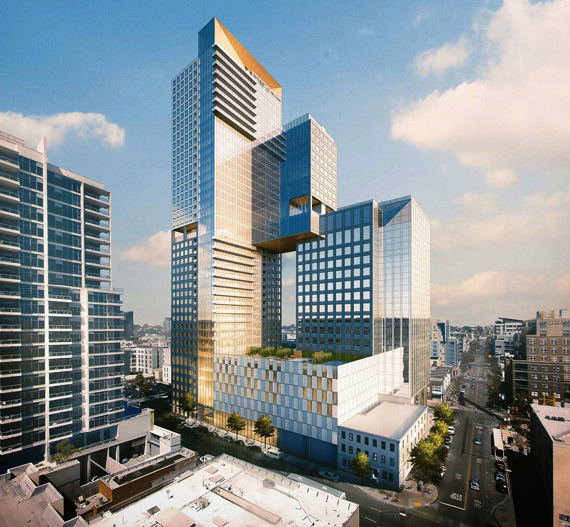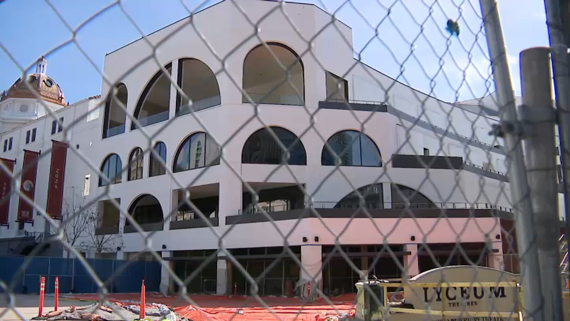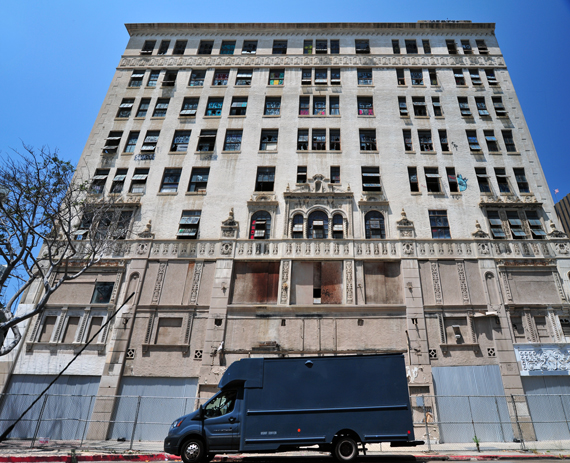|
Downtown’s Decline
How Misguided Development is Undermining Our City's Future
By Bruce Coons
SOHO Executive Director
March/April 2025
 Artist rendering of the canceled Ritz-Carlton project, which would have included the restoration and adaptive reuse of the historic Clermont Hotel. Courtesy Cisterra Development |
 Horton Plaza, project stalled. Courtesy NBC News |
 California Theater, project stalled. Photo by Sandé Lollis |
San Diego’s shift away from downtown as the focal point for high-density development and investment is deeply misguided. Downtown San Diego is uniquely suited to support high-density housing and mixed-use projects, thanks to its existing infrastructure, central location, and vibrant cultural and economic hubs, like the main library, the Ballpark District, and the Gaslamp Quarter District. Additionally, it holds a wealth of historic buildings that, through adaptive reuse, could play a key role in revitalizing the urban core while maintaining San Diego’s unique identity.
Instead, we’re seeing millions of square feet of prime real estate downtown go underutilized. These spaces could and should be transformed into a thriving, dynamic blend of housing, diverse businesses, restaurants, schools, and museums and other cultural institutions. These buildings could and should be transformed into a thriving urban core, including a dynamic blend of high-end and affordable housing. Such development would complement the area’s popular existing assets while driving economic growth and funding civic improvements, like a much-needed new city hall.
Moreover, the disastrous wildfires in Los Angeles highlight a critical issue: how we plan and build in areas prone to natural disasters. Downtown San Diego, with its dense urban core, paved streets, and minimal vegetation, is naturally more defensible against wildfires compared to neighborhoods like Hillcrest, North Park, and South Park, which are built along canyons and natural brush zones. Prioritizing high-density development downtown would not only take advantage of this safer environment, but, crucially, also reduce the number of lives and structures at risk in fire-prone areas.
By diverting development and resources to outlying neighborhoods ill-equipped to handle high-density growth—we’re not just misallocating resources; we’re threatening the character and livability of these historic neighborhoods. Worse, this approach risks turning much of the city into a patchwork of poorly planned density, which is likely to lead to long-term urban decay.
Additionally, downtown’s grid pattern is ideal for dense development and efficiently moving high volumes of traffic, while areas like Hillcrest are uniquely unsuited for high density growth. With its narrow streets and dead-end canyons, Hillcrest is an ever-worsening nightmare of normal traffic, not to mention potential evacuations.
These established neighborhoods have long been models of walkability, sustainability, and historic charm. Treating them as blank slates for high-density development disregards their architectural and social significance and threatens to erase the very qualities that make them so desirable in the first place.
The current failure to invest in downtown is puzzling, as investing in the core’s renaissance was the city’s crowning priority only two and three decades ago and abandoning downtown now is endangering all that renewal. Meanwhile, overburdening historic neighborhoods today stems from a lack of leadership that understands both past and recent city history, urban planning, and good design. Short-sighted policies have already led to the unnecessary loss of valuable historic structures, weakening the identity of both downtown and our surrounding communities.
Instead of continuing down this flawed path, San Diego should recognize that historic preservation and smart growth are not at odds. A well-planned city embraces both—leveraging downtown’s existing infrastructure and historic assets to create and enhance the vibrant, high-density urban core our city needs.
Both SOHO and San Diegans showed strong support when the City Council voted in 2006 to allow developers to increase density in downtown commercial and residential projects. That decision was meant to accommodate the burgeoning downtown community, which was then expected to double its workforce by 2030, according to the Centre City Development Corporation (CCDC).
“By taking the density downtown, we are helping preserve our rural lands and our single-family neighborhoods,” CCDC Chairwoman Jennifer LeSar said at the time.
This misguided shift of density and investment away from downtown has played a significant role in the downfall of key projects like Horton Plaza, the Ritz-Carlton, and the California Theatre. If this trend continues, downtown will face an inevitable decline, losing its viability as a thriving community. Worse, it will squander one of our greatest opportunities to address the housing crisis, pushing the area back into stagnation. By diverting attention elsewhere, they are neglecting downtown—allowing crucial projects to fail while the heart of the city is left to languish.
BACK to table of contents
|
2025
2024
2023
2022
2021
2020
2019
2018
2017
2016
2015
|






